ONDA is the only organization dedicated exclusively to protecting Oregon’s high desert public lands. We work across millions of acres of eastern Oregon’s public lands to protect wilderness, conserve essential habitat for fish and wildlife, promote climate resiliency, and maintain healthy ecosystems. Through advocacy, community engagement and strategic partnerships, we conserve key Oregon desert landscapes and support strong conservation management of public lands.
Both fragile and finite, Oregon’s desert public lands include some of the most biologically significant sagebrush habitat remaining in North America. Only a fraction of the high desert is currently permanently protected, while climate change, industrial development and other concerns continue to threaten this beloved region.
Conservation Priorities
Oregon’s high desert is characterized by impressive rivers, craggy canyons, stunning peaks and a veritable sea of sagebrush stretching across eastern Oregon. Our conservation work is focused on five priority landscapes:
- Owyhee Canyonlands
- John Day River Basin
- Central Oregon Backcountry
- Greater Hart-Sheldon
- Steens Mountain Region
Conserving Focal Landscapes
The Bureau of Land Management oversees millions of acres of public lands in Oregon’s high desert, managing them for a variety of uses, while also seeking to preserve natural, cultural and historic resources.
The U.S. Congress—and even the president—can take action to strengthen conservation and protect public lands and waters by designating wilderness areas, national monuments, national conservation areas, national parks, wild and scenic rivers and more.
Oregon Natural Desert Association identifies conservation needs and opportunities and mobilizes supporters to encourage elected leaders to protect deserving public lands across our focal landscapes. We have successfully led campaigns that established the only wilderness areas, the strongest protective designation available, in Oregon’s high desert:
Some eight million acres of exceptional desert public lands in Oregon are still in need of permanent protection. While wildlands and biodiversity are at risk, conservation solutions are at hand. Learn more about ONDA’s ongoing work to conserve key landscapes with protective designations:
Learn more about ways you can support public lands conservation.

